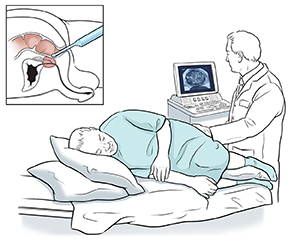Prostate Ultrasound
Prostate Ultrasound

When ultrasound is used
You may need ultrasound on your prostate if your healthcare provider thinks you may have prostate cancer. An ultrasound is most often done after a digital rectal exam (DRE) or a PSA blood test. These are screening tests for prostate cancer.
How ultrasound helps
Ultrasound uses sound waves to create an image of the prostate gland. It helps your healthcare provider see if the gland looks abnormal. It can also be used to help guide a biopsy. This is a procedure that removes tiny pieces of tissue to test. A prostate biopsy is done with a needle. Ultrasound helps your healthcare provider see where to put the needle.
If you have prostate cancer, you may choose to treat it with radioactive “seeds.” Ultrasound can also be used to help your healthcare provider see while placing these seeds into the prostate.
Before the procedure
You may be told to use an enema or suppository the night or morning before. This is to clear your rectum of stool. The test is often done in your healthcare provider’s office. It usually takes less than 15 minutes.
If a biopsy may be done, you might be asked to stop taking blood-thinning medicines like aspirin for a week or so before the test. This helps lower the risk of bleeding. You might also be given antibiotics before and after the test.
During the procedure
What happens during the procedure:
You lie on your side with your knees bent or with your feet in stirrups.
A disposable cover is put on the ultrasound probe. The probe is tube-shaped and a bit larger than a thumb. A jelly is put on the probe to lubricate it.
Your healthcare provider gently inserts the probe into your rectum. This may cause some discomfort.
The probe emits sound waves. These create an image of your prostate on a computer screen. Your healthcare provider looks at the image. The size and shape of your prostate are checked for problems.
When the test is done, the probe is removed.
You can go home the same day, and go back to your normal activities.
Updated:
May 19, 2017
Reviewed By:
Alteri, Rick, MD,Gersten, Todd, MD